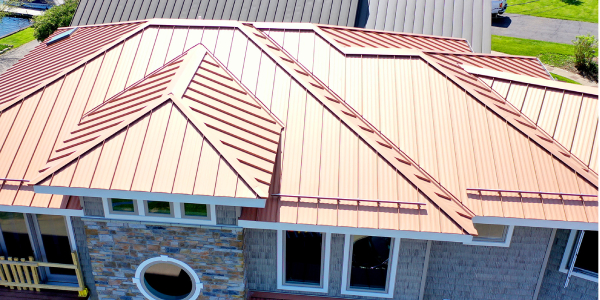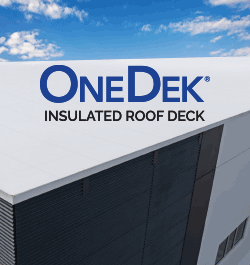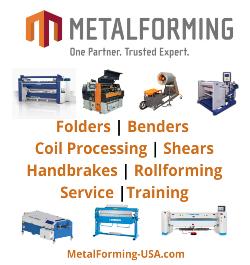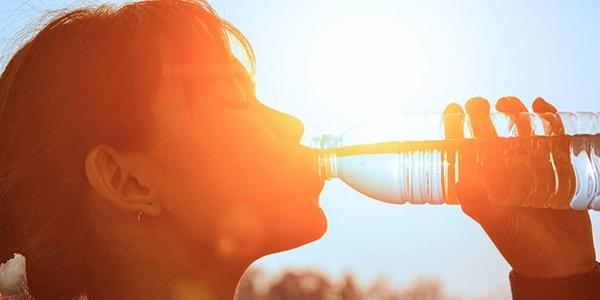UP TO THE MINUTE
Busting 5 metal roofing myths!

By Julianne Calapa, Sheffield Metals.
From lightning strikes to risk of rusting and more, learn the facts about metal roofing!
Editor’s note: Share this article with your customers who are considering having a metal roof installed and want to know the facts about metal.
Metal roofing is gaining a lot of popularity for its durability and lifespan. It hosts a myriad of benefits but has gained a lot of myths as it has gotten more and more attention. It’s important to stay ahead of these myths and know the facts about metal roofing materials. Though they don’t know the origin of most of these myths, the experts here at Sheffield Metals want to set the record straight on the common metal roofing myths they hear, separating fact from fiction and helping readers know what to expect from a metal roof.
1 - Metal roofing attracts lightning
We are taught at a young age to never hold anything made up of metal during a thunderstorm because “metal objects attract lightning.” But did you know this is actually another myth?
The idea that metal attracts lightning is partly because most lightning rods put on top of buildings are made of metal. But these rods don’t actually attract lightning strikes; instead, the metal rod acts as a conductor of electricity and channels the electricity safely to the ground, so it doesn’t damage the building.
So, what does this mean? Metal roofing does not increase the risk or likelihood of lightning strikes. It has the same possibility as any other material to be struck by lightning. According to the Metal Construction Association, the probability of a lightning strike is determined by several other factors, such as:
- Topography of the land: Lightning is very unpredictable and difficult to measure, but scientists have determined that lightning’s electric current takes the path of least resistance. Based on this fact alone, lightning is more likely to strike at higher ground, such as a mountain or hilltop.
- Size of the building: The likelihood of lightning striking is higher if a building is large because it covers more area.
- Location of a structure among other buildings: If a smaller building is next to a larger or taller building, the smaller building is less likely to be struck by lightning.
- Thunderstorm frequency: Weather patterns and frequency of thunderstorms vary depending on where you live. For example, a home in Arizona would have to worry less about lightning than a home in Kansas.

In reality, metal is one of the most preferred roofing materials when concerned with lightning safety. Metal is non-combustible (unlike shingles or wood), meaning it’s incapable of igniting or burning. This is a huge advantage if a metal roof were to be struck by lightning because it wouldn’t explode or catch on fire and could protect a structure from damage.
Additionally, if you want to help eliminate the threat of lightning striking your home or building, there are lightning protection systems that can be installed on a home for further safety.
2 - Metal roofs are noisy
There is a common misconception that all types of metal roofs make a lot of noise during rain or hailstorms. While it is true that some systems and profiles of metal roofing can experience noise in certain circumstances, most metal roofs are designed and installed to be no louder than any other roof type. Some can even be quieter.
That being said, there are home or building owners who want to hear the noise of rain/hail. Luckily, you can have metal roofing installed in a way that makes noise as loud or as quiet as you prefer. Let’s dive a little deeper into ways to ensure a roof doesn’t experience unnecessary noise:
- Structure/roof deck: If a structural metal roof, like a corrugated exposed fastener roof (common with barns and other agricultural structures), is installed directly over open framing or spans long lengths by attaching to the frame or purlins, noises from rain or hail will be more noticeable. This happens because there isn’t a buffer between the panels and the inside of a structure, such as a roof deck, sheathing or insulation, to muffle the noise.
- Restricting thermal movement: When you restrict the expansion and contraction needed for proper thermal movement of a metal panel, you can run into a noise issue and other potential problems (such as oil canning).
- Insulation: Insulation is another element that can be added to a roofing structure to reduce noise. Insulation comes in many forms and can be installed above or below the roof deck and between the beams or purlins of an open frame for noise reduction and temperature control. During installation, make a point to ask the installer to ensure the insulation allows for adequate thermal movement.
- Installer knowledge: The best way to ensure a roof doesn’t generate extra noise is to hire a qualified and experienced contractor knowledgeable about properly installing metal roofing. If you are unsure of where to start to look for an installer, ask for referrals from family, friends and neighbors or visit a third-party referral website like HomeAdvisor.

3 - All metal roofs develop red rust over time
It’s true that most metals rust or develop a patina over time when in contact with oxygen and water, also called oxidation. However, not all metals rust with the reddish-brown color that we typically associate it with. While rusting is an inherent characteristic of most metals, the metal coils and sheets that become metal panels are engineered, coated and tested to prevent rust formation for as long as possible. To easily understand why this is, let’s go through each popular metal material individually:
- Galvalume®: Galvalume combines three of the most high-performing and important metals used in roofing today — steel, aluminum and zinc. Manufacturers begin with a cold-rolled carbon steel base sheet that is continuously hot-dipped with aluminum and zinc alloys (AZ) until it reaches a coating of 55% aluminum, 43.4% zinc and 1.6% silicone. This process allows for one material to have some of the best characteristics of each metal.
- Many old rusty roofs that people see are traditionally older galvanized roofs (cold-rolled) or COR-TEN®, which are materials designed to rust. Galvalume was created to have self-healing characteristics that regular galvanized roofing does not.
- Any steel roof, including Galvalume, can rust quickly if it’s scratched, perforated or not properly maintained, especially where there are cut edges without proper hems.
- Aluminum: One of the biggest selling points of an aluminum roof is that it doesn’t have red rust and corrosion is generally minimal as it ages. Aluminum actually develops white rust that blends well with the color of the metal.
- Aluminum is often the best material to use in coastal areas with high rainfall and seawater spray conditions because it defends against rusting for longer.
- Copper: Copper doesn’t rust, but it will develop a protective covering called patina, which develops due to oxidation and sun exposure. There’s no exact science as to when patina will show up or what color it becomes; it can range from a dark bronze to a blueish-green covering.
- Zinc: Zinc is another material that doesn’t develop red rust. In fact, when zinc is exposed to carbon dioxide and moisture (present in our atmosphere), it forms its own protective patina layer called zinc carbonate, which helps further resist corrosion.
- Stainless steel: This steel alloy is made up of at least 10.5% chromium, which makes stainless steel rust resistant. That being said, there are architectural stainless steels specifically formulated to develop a patina similar to zinc. (Learn more about specialty metal roofing materials here.)
In addition to metals used for coils and sheets, the paint systems applied on top of the metal are designed to help prevent rusting and corroding. Plus, if any of these paint systems or metals do rust or fail before promised, most reputable manufacturers offer some type of paint or substrate warranty to buyers.
4 - Metal roofs dent easily
Contrary to popular belief, metal roofing is actually very difficult to dent and even more difficult to puncture. Consumers are always concerned that the first time a wave of hail rolls through, there will be dents all over a metal roof. In actuality, the average hailstorm is very unlikely to cause damage or dent a metal roof. The possibility for denting increases as the size and quantity of the hailstones increase, but it would take a huge storm with extremely large pieces of hail to create any significant denting or penetration points.

Luckily, an industry guideline called the Standard for Impact Resistance of Prepared Roof Covering Materials (or UL 2218), exists to test a metal panel’s resistance to hail and other items it could come into contact with. The products tested are rated on a scale from Class 1 to 4, with Class 4 being the toughest and least likely to dent and/or fail when in contact with items such as hail. For an example of a UL 2218 certification, view Sheffield Metals 1.5″ SnapLock 550 Class 4 documentation.
If you live in an area where hailstorms occur, consider a metal roof with a rib roller or striation in the flat part of the panel because it could help hide any denting that could show up after a large hailstorm.
It’s important to note that many home insurance companies offer hail damage waivers, which lower premium prices but waives the insurance company from covering a claim for repairs or replacements caused by hail. Just be aware that these kinds of waivers exist and make sure to do your research ahead of time before signing.
5 - Metal roofs hold heat in the summer
This is another myth we attribute to what we learn when we are young: Metal in the sun holds heat for a long time. While this is a true statement, it doesn’t always apply to panels used in metal roofing anymore.
Advancements in metal roofing technology and sustainability have contributed to the creation of cool metal roofing, which are highly emissive metal panels with a high Solar Reflective Index (SRI). For reference:
- Solar reflectance: Solar reflectance is the ability of a material to reflect solar energy from its surface back into the atmosphere. Solar reflectance is measured in decimals on a scale from 0 to 1, where 0 would be considered the truest black and 1 would be considered the truest white.
- Emissivity: Emissivity measures how efficiently and quickly a surface releases/emits absorbed heat and returns to its normal temperature. Emissivity is determined on a decimal scale from 0 to 1, where a 1 represents the most efficiently emissive material possible. In essence, the higher the number, the better it will be at cooling itself.
- SRI: Solar Reflectance Index measures a surface’s ability to reflect the sun’s solar energy (solar reflectance) and emit heat (emissivity). SRI is measured on a scale from 0 to 100. An SRI value closer to 0 indicates a darker or black surface and a value closer to 100 indicates a brighter or white surface. SRI is a little more complicated to define because it’s measured using a complex formula that includes more than the solar reflectance and emissivity values.
In addition to a longer lifecycle and other metal roofing benefits, this cool roofing is energy-efficient and eco-friendly. The best part for consumers is that these cool metal roofs come in various colors, finishes, profiles and slope applications.
So, not all metal roofing holds on to heat during hotter months. If you have questions or concerns about the temperatures associated with the metal used on your roof, have a conversation with the coil or sheet manufacturer to determine the best choice for your building application.
Final thoughts on metal roofing myths
Myths will always exist with metal roofing, but becoming an educated and informed consumer helps you determine fact from fiction. And if you know the facts, you’ll be fully equipped to make the best decision. Keep in mind:
- Metal roofing won’t attract lightning more than any other material.
- Rain or hail is not any louder on metal roofing, especially if insulation, sheathing or a solid roof deck is present.
- Your metal roof is designed to resist red rust formation, and some metals used in roofing are naturally more rust-resistant than others. To further ensure rust doesn’t creep in, keep an eye out for exposed cut edges and deep scratches or scrapes on steel panels.
- A typical hailstorm will not dent a metal roof; only abnormally large hailstones can significantly dent or penetrate a roof.
- Cool metal roof coatings were invented to emit heat and reflect the sun’s rays during the summer, which helps stabilize a structure’s temperature.
Original article source: Sheffield Metals
Learn more about Sheffield Metals International in their Coffee Shop DIrecotry or visit www.sheffieldmetals.com.





















Comments
Leave a Reply
Have an account? Login to leave a comment!
Sign In